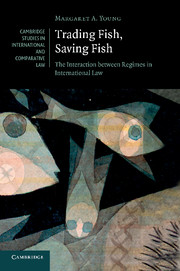Book contents
- Frontmatter
- Contents
- Foreword
- Acknowledgements
- Table of cases
- Table of Conventions, Declarations and procedures
- List of abbreviations
- Part I Trading Fish, Saving Fish
- Part II Selected Case Studies
- Chapter 3 The negotiation of WTO rules on fisheries subsidies
- Chapter 4 The restriction of trade in endangered marine species
- Chapter 5 Adjudicating a fisheries import ban at the WTO
- Part III Towards Regime Interaction
- Appendices
- Bibliography
- Index
- CAMBRIDGE STUDIES IN INTERNATIONAL AND COMPARATIVE LAW
- References
Chapter 5 - Adjudicating a fisheries import ban at the WTO
Published online by Cambridge University Press: 28 April 2011
- Frontmatter
- Contents
- Foreword
- Acknowledgements
- Table of cases
- Table of Conventions, Declarations and procedures
- List of abbreviations
- Part I Trading Fish, Saving Fish
- Part II Selected Case Studies
- Chapter 3 The negotiation of WTO rules on fisheries subsidies
- Chapter 4 The restriction of trade in endangered marine species
- Chapter 5 Adjudicating a fisheries import ban at the WTO
- Part III Towards Regime Interaction
- Appendices
- Bibliography
- Index
- CAMBRIDGE STUDIES IN INTERNATIONAL AND COMPARATIVE LAW
- References
Summary
[T]he Appellate Body has, on occasion, been forced to confront strong arguments that its interpretation should not be totally confined to embellishing trade policies … This is an area that the jurisprudence will need to develop further.
This chapter investigates the interaction that occurs between the WTO and other regimes in the settlement of trade disputes. I take as my case study the dispute brought at the WTO against a United States import ban on shrimp from certain countries. This ban was part of a series of US measures designed to prevent the drowning of sea turtles in shrimp trawling nets; the United States claimed that the ban was justified for environmental reasons. The WTO panel and Appellate Body (AB) applied WTO law to resolve the dispute, but drew also on fisheries law and international environmental law in establishing relevant facts and in interpreting WTO treaty norms. This chapter considers these methods and compares regime interaction in other relevant WTO cases.
In doing so, the chapter uses the term ‘non-WTO sources’ to describe treaties, other rules of international law, standards, guidelines and other materials produced by international bodies outside of the WTO. Some of these sources, such as CITES, are binding on at least some of the WTO members. Others have a non-binding character but still serve to guide the behaviour of states, such as the Resolution on Assistance to Developing Countries adopted in conjunction with the Convention on the Conservation of Migratory Species of Wild Animals (CMS), on which the AB partly relied in US – Shrimp.
- Type
- Chapter
- Information
- Trading Fish, Saving FishThe Interaction between Regimes in International Law, pp. 189 - 240Publisher: Cambridge University PressPrint publication year: 2011



